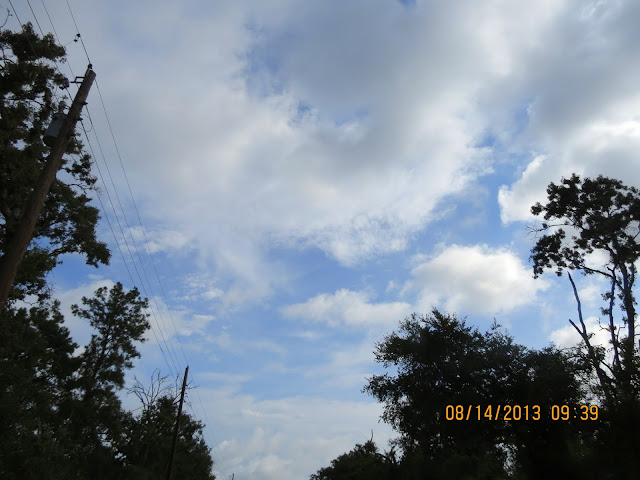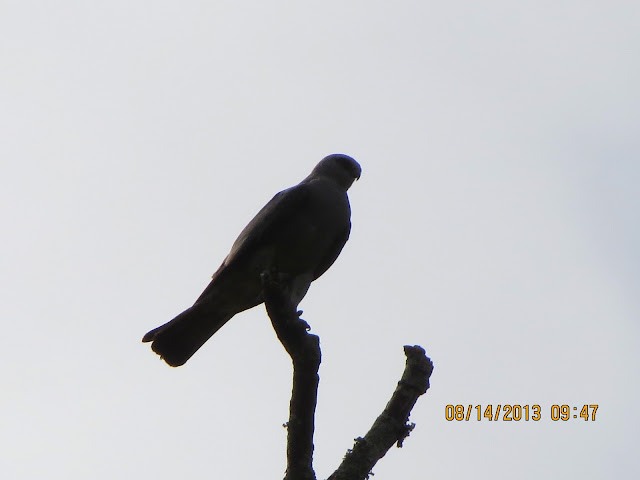What is a silhouette? I have the Wikipedia definition here for You (below). In regards to photography, a silhouette is an object that is backlit. Usually, You would notice an outline, but not details on the dark side. In your photostudy tonight the Kites are silhouetted by the cloudy, white sky of yesterday. This is the first year I have seen so many Kites. This is the first year they have attempted to be friendly to me and seek me out. Now we whistle at each other and they come out when they see me walking! I am a lucky lady to enjoy so many Birds! I am glad You are getting to know the birds also.
Mom would be thrilled! Enjoy!
http://en.wikipedia.org/wiki/Silhouette
Silhouette
From Wikipedia, the free encyclopedia
A silhouette is the image of a person, an object or scene represented as a solid shape of a single colour, usually black, its edges matching the outline of the subject. The interior of a silhouette is featureless, and the whole is typically presented on a light background, usually white, or none at all. The silhouette differs from an outline which depicts the edge of an object in a linear form, while a silhouette appears as a solid shape. Silhouette images may be created in any visual artistic media,[1] but the term normally describes pieces of cut paper, which were then stuck to a backing in a contrasting colour, and often framed.
Cutting portraits, generally in profile, from black card became popular in the mid-18th century, though the term “silhouette” was seldom used until the early decades of the 19th century, and the tradition has continued under this name into the 21st century. They represented a cheap but effective alternative to the portrait miniature, and skilled specialist artists could cut a high-quality bust portrait, by far the most common style, in a matter of minutes, working purely by eye. Other artists, especially from about 1790, drew an outline on paper, then painted it in, which could be equally quick. The leading 18th-century English "profilist" in painting, John Miers, advertised "three minute sittings",[2] and the cost might be as low as half a crown around 1800. Miers' superior products could be in grisaille, with delicate highlights added in gold or yellow, and examples might be painted on various backings, including gesso, glass or ivory.[3] The size was normally small, with many designed to fit into a locket, but otherwise a bust some 3 to 5 inches high was typical, with half- or full-length portraits proportionately larger.
From its original graphic meaning, the term "silhouette" has been extended to describe the sight or representation of a person, object or scene that is backlit, and appears dark against a lighter background. Anything that appears this way, for example, a figure standing backlit in a doorway, may be described as "in silhouette". Because a silhouette emphasises the outline, the word has also been used in the fields of fashion and fitness to describe the shape of a person's body or the shape created by wearing clothing of a particular style or period.

Photography
Many photographers use the technique of photographing people, objects or landscape elements against the light, to achieve an image in silhouette. The light might be natural, such as a sunset or an open doorway, a technique known as contre-jour or it might be contrived in a studio; see low-key lighting. Silhouetting occurs when there is a lighting ratio of 16:1 or greater. The exposure is set for the background, usually with an aperture at 9–11 and a shutter speed around 120–200.
Please see above link for complete articleA White Silhouette:
http://en.wikipedia.org/wiki/Accipitridae
Accipitridae
From Wikipedia, the free encyclopedia
The Accipitridae, one of the two major families within the order Accipitriformes (the diurnal birds of prey), are a family of small to large birds with strongly hooked bills and variable morphology based on diet. They feed on a range of prey items from insects to medium-sized mammals, with a number feeding on carrion and a few feeding on fruit. The Accipitridae have acosmopolitan distribution, being found on all the world's continents (except Antarctica) and a number of oceanic island groups. Some species are migratory.
Many well-known birds, such as hawks, eagles, kites, harriers and Old World vultures are included in this group. The Ospreyis usually placed in a separate family (Pandionidae), as is the Secretary bird (Sagittariidae), and the New World vultures are also usually now regarded as a separate family or order. Karyotype data[1][2][3] indicated that the accipitrids hitherto analysed are indeed a distinct monophyletic group, but whether this group should be considered a family of the Falconiformes or one or several order(s) on their own is a question that is still to be resolved.
http://nationalzoo.si.edu/scbi/migratorybirds/featured_birds/default.cfm?bird=Mississippi_Kite
MISSISSIPPI KITE
BUOYANT IN FLIGHT
By Alexandre Gavashelshvili
Published: August 1997
Not many raptors can match the buoyancy, ease and grace with which Mississippi kites conquer the sky. During their brief courtship period, the kites' aerial displays to their prospective mates are a sight to behold.
Throughout the year, they occupy much of their time in flight during which they catch large flying insects, mostly dragonflies, on the wing.
As soon as a kite locates suitable prey it dashes and catches it in midair with its talons, and often eats it in flight. They sometimes takes insects on the ground and in trees, and will readily take every opportunity to grab reptiles, amphibians and any other small living creatures as well.
As the fall sets in and the flying insects slowly disappear, Mississippi kites gather in large flocks for their southbound migration, spending the winter in South America as far south as Argentina, and returning north during the warm days of mid-April. Each spring and fall several thousand migrating kites are seen funneling through a narrow pathway at the southernmost tip of Texas.
See above link for complete article and more info on migratory birds
All the rain in Texas missed me. NO RAIN HERE
...this is brendasue signing off from Rainbow Creek. See You next time! A great night for Kites! Soon they will be gone until next year. Love the moment You are in!
O+O
















































































































No comments:
Post a Comment
Hi Everybody! Please say hello and follow so I know you are here! Due to the inconsideration of people trying to put commercials on my blog comment area, I have restricted use of anonymous posts. Sorry that some hurt all.
My public email is katescabin@gmail.com No spammers or trolls